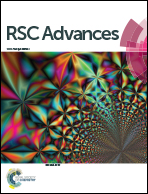A facile, fast responsive and highly selective mercury(ii) probe characterized by the fluorescence quenching of 2,9-dimethyl-1,10-phenanthroline and two new metal–organic frameworks†
Abstract
A fast responsive and highly selective mercury(II) sensor was developed using the fluorescence quenching mechanism of 2,9-dimethyl-1,10-phenanthroline (2,9-DMP) towards mercury(II). Furthermore, two kinds of metal–organic frameworks (MOFs) of 2,9-DMP–Hg(II) have been synthesized and characterized by X-ray diffraction. The probe 2,9-DMP exhibited a fast and highly selective response to mercury(II) ions in aqueous solution, showing a good linear relationship over the concentration range of 0.050–2.0 μM for Hg(II) with R2 = 0.9994. The established procedure was used to monitor the concentration of mercury(II) in drinking water and Zhujiang River water samples with satisfactory recoveries of 85.42–101.5% and 81.72–96.09%, respectively. Furthermore, the fluorescence quenching mechanism of 2,9-DMP by mercury(II) was investigated and clarified by the data of single crystal X-ray diffraction of MOFs and the Job's plot analyses of 2,9-DMP towards Hg(II).


 Please wait while we load your content...
Please wait while we load your content...